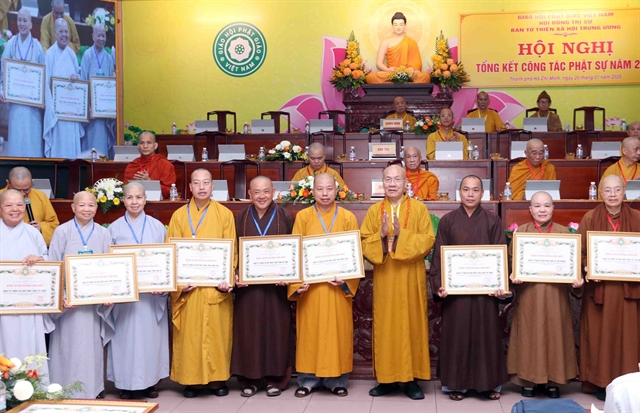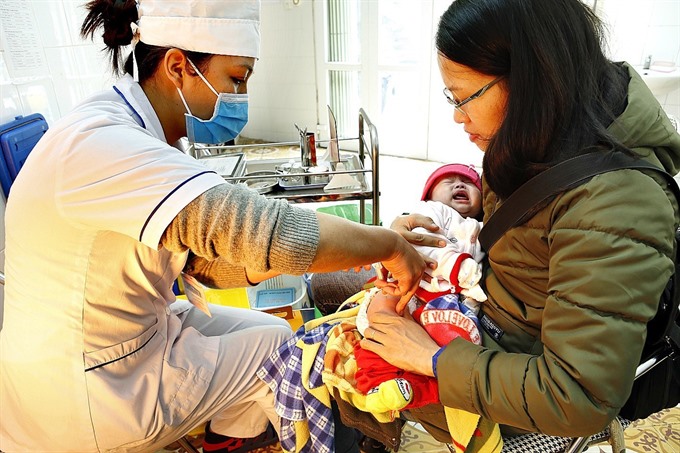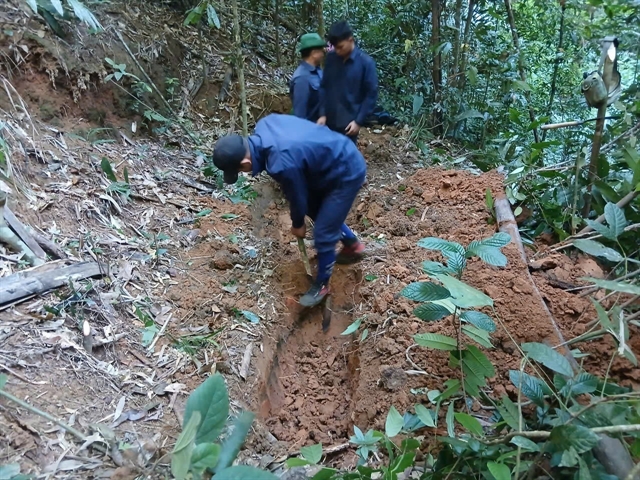 Society
Society

Six children were admitted to Điện Biên Province General Hospital on Sunday suffering side effects of the ComBE Five vaccine, three of them had serious reactions.
 |
| An infant in Hai Bà Trưng District, Hà Nội receives the ComBE Five vaccine. - VNA/VNS Photo Dương Ngọc |
ĐIỆN BIÊN – Six children were admitted to Điện Biên Province General Hospital on Sunday suffering side effects of the ComBE Five vaccine, three of them had serious reactions.
Nguyễn Thị Kim Ngân from the hospital’s department of pediatrics said a 4-month-old was the first one hospitalised on Sunday morning with shortness of breath, high fever, cyanosis and uncontrollable cry.
On the same day’s afternoon, five more child patients were transferred.
After receiving antipyretic injections and treatment, their health was stable.
One of the mother’s, said her son got severe reactions an hour after the immunisation at Him Lam District Health Centre.
Điện Biên Province started using ComBE Five vaccine from Sunday on 333 children in Điện Biên Phủ City and 25 others in Tủa Chùa District.
Minor side effects were reported on 14 children while three others suffered severe reactions.
Đoàn Ngọc Hùng, director of Điện Biên Province Disease Control Centre, told parents not to panick as the vaccine was confirmed safe and it was normal for children’s bodies to react.
Parents are instructed to monitor body temperature and take them to nearest medical clinics in case of any severe reaction. At a conference Monday on the national expanded immunisation program hosted by the Ministry of Health, Đặng Đức Anh, head of the National Institute of Hygiene and Epidemiology, said that 101,862 children had been injected with the vaccine.
Until Sunday, it had been used in 19 localities including Hà Nội, Yên Bái, Quảng Nam, Đắk Lắk, Cần Thơ and Kiên Giang.
According to local reports, normal reactions such as mild fever or slight pain at injection site are reported in 1.73 per cent of the children. 0.05 per cent of vaccinated children having high fever stabilised after being treated by doctors.
“Parents need to tell doctors about their children’s health conditions, medicines they take, history of allergy and any reaction in previous immunization,” said Trần Đắc Phu, head of MoH’s General Department of Preventative Medicine.
“Children need to stay at medical centres 30 minutes after immunisation for doctors to monitor and properly handle in case of abnormal reactions.”
ComBE Five produced by Indian-based Biological E. Ltd will replace Korean-made Quinvaxem vaccine which has been used in Việt Nam’s national expanded immunisation programme.
The five-in-one vaccine can help fight against five common, potentially fatal diseases affecting infants - diphtheria, tetanus, whooping cough, hepatitis B and Haemophilus influenza type B.
According to health experts, ComBE Five has the same quality and ingredients as Quinvaxem.
More than 400 million doses of ComBE Five have been used for children in 43 countries and territories since it was approved by World Health Organisation.
In May 2017, ComBE Five obtained a license from the Ministry of Health. The vaccine was first administrated for more than 17,300 children in seven provinces of Hà Nam, Bắc Giang, Yên Bái, Kon Tum, Bình Định, Đồng Tháp and Bà Rịa Vũng Tàu.
About 5.5 per cent of the children had minor side effects but three had severe reactions, including high temperature, seizures and trouble breathing.
After piloting the vaccines, the National Institute of Hygiene and Epidemiology and the national expanded immunisation program started distributing ComBE Five to all 63 provinces and cities with the instruction on implementation, safe practice, pre-injection screening and post-injection care.
According to General Department of Preventative Medicine, till November 2018, some 27,800 children had reactions after vaccinated including 32 severe cases. Twenty nine of them well recovered while the other died after receiving Quinvaxem and BCG vaccines.
Out of 3.5 million doses of Quinvaxem used in 2018, 20 children got severe reactions after immunisation.
Sixty eight per cent of post-injection reactions is due to anaphylaxis, 19 per cent by unknown causes and 13 per cent by children’s pre-existing diseases. – VNS




